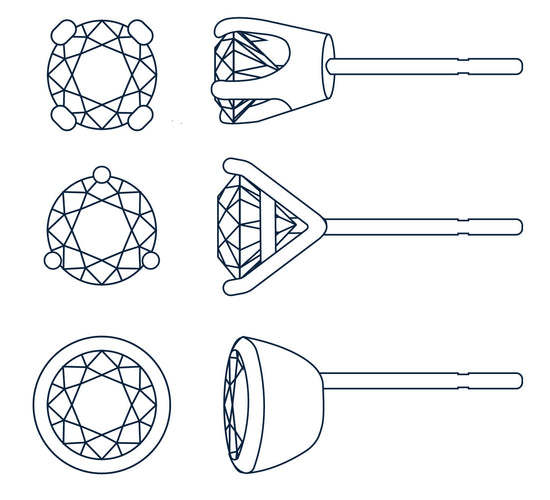Lylie’s Sustainable Jewellery can help you design the perfect pair of bespoke diamond studs. The process begins by selecting an antique recycled or man-made diamond that we can either source for you, or reuse from an unloved piece of jewellery. To ensure the highest quality diamond, we check its cut, colour, clarity, and carat weight, known as the 4Cs. The cut is the most important factor of diamond quality and there are endless styles to choose from. Brilliant-cut 'round' stones are by far the most popular option for diamond studs, but, for a more unusual look, why not try a trillion-cut ‘triangle' stone or a carré-cut 'square' stone. Further information on diamond cuts can be found here. Once you have found your ideal diamond, the next stages are selecting the diamond setting; the stud style; and lastly the stud back.
Decision 1- Settings
CLAW SET

Claw settings hold the diamond with metal projections, referred to as prongs. Stones in studs are usually held by 3 or 4 prongs, although some antique designs have up to 8.
BEZEL SET

Bezel settings hold diamonds by enclosing them within a metal band. They are considered safer than prong settings but conceal more of the diamond’s surface.
Decision 2 - Style
These styles differ most notably in the shape of their bottom, as well as in how far the diamond sits from the earlobe.
MARTINI-STYLE

Martini-style settings are shaped like a cone (the v-shape resembles a martini glass from the side). The diamond is set close to the ear, and as a result, the earring is less likely to droop. Some dislike its conical shape, since it can dig into and stretch the piercing hole. The likelihood of this varies from person to person and many never experience any problems, however, it is something to consider.
BASKET-STYLE

Basket-style settings have a flat bottom, and the stones are generally set further from the ear than martini-style settings. This is a great choice if you are concerned that martini-style studs could dig into your ear.
CROWN-STYLE

Similar to basket-style settings, the crown-style setting has a flat bottom, but its sturdier construction causes the diamond to sit further from the ear creating a noticeable difference.
Decision 3 - Backs
STEM & BUTTERFLY
 Butterfly backs are the most common stud back type. They consist of a disc with two curled edges that push against the post, using tension to keep them in place. Easy to use, they are the most convenient back, but, over time, they may lose their tension and require replacing.
Butterfly backs are the most common stud back type. They consist of a disc with two curled edges that push against the post, using tension to keep them in place. Easy to use, they are the most convenient back, but, over time, they may lose their tension and require replacing.
LA POUSSETTE BACKS
 La Poussette backs feature a disc with opposing spring-loaded clips that latch onto a specially designed post. To release the back from its post, pinch the clips. These backs are easy to use, comfortable, and secure.
La Poussette backs feature a disc with opposing spring-loaded clips that latch onto a specially designed post. To release the back from its post, pinch the clips. These backs are easy to use, comfortable, and secure.
SCREW STEMS & BACKS
 Screw Stems are jeweller's number one choice for security. They comprise a nut spun along a threaded post. Changing them is a time-consuming process, so they are best suited for earrings that you are unlikely to switch. Another consideration is that those with sensitive ears may find the thicker, threaded post irritating.
Screw Stems are jeweller's number one choice for security. They comprise a nut spun along a threaded post. Changing them is a time-consuming process, so they are best suited for earrings that you are unlikely to switch. Another consideration is that those with sensitive ears may find the thicker, threaded post irritating.
To read why Lylie’s Sustainable Jewellery exclusively uses man-made diamonds (indistinguishable from natural ones) or antique recycled diamonds click here.
Words
Eliza Walter
Images
Danae Papazymouri












